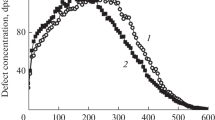Abstract
This study presents the first unequivocal identification of natural radiation-induced defects in illites. Middle Proterozoic illites related to unconformity-type uranium deposits of Canada and Australia were studied using electron paramagnetic resonance (EPR) spectroscopy at X- and Q-band frequencies. The saturation behaviour of EPR spectra as a function of power demonstrates that native defects of illites are different from those known in other clays as kaolinite, dickite or smectite. Q-band spectra indicate the presence of several––at least two––native defects. The EPR signal is dominated by an axially distorted spectrum with apparent principal components as follows: g ∥ = 2.032 and g ⊥ = 1.993. The corresponding defect is named as Ai center. The study of oriented specimen confirms the strong anisotropy, and shows that the main defect has its g ∥ component perpendicular to the (ab) plane of illite. These defects in illite correspond to electron holes located on oxygen atoms of the structure and likely associated to Si, according to the lack of hyperfine structure. The Ai center in illite has similar EPR parameters to the A center in kaolinite and dickite. The isochronal annealing data suggest that illite can be used as a dosimeter in the geosphere. However, the determination of half-life and activation energy of the Ai center requires additional work.








Similar content being viewed by others
References
Allard T, Muller JP (1998) Kaolinite as an in situ dosimeter for past radionuclide migration at the Earth’s surface. Appl Geochem 13(N°16):751–765
Allard T, Ildefonse P, Villar LPd, Sorieul S, Pelayo M, Boizot B, Balan E, Calas G (2003) Radiation-induced defects in dickites from the El Berrocal granitic system (Spain): relation with past occurrence of natural radioelements. Eur J Mineral 15:629–640
Beaufort D, Patrier P, Laverret E, Bruneton P, Mondy J (2005) Hydrothermal clay minerals associated to unconformity-type uranium deposits in the Alligator River Uranium Field (Northern Territory, Australia). Econ Geol 100:515–536
Calas G, Allard T, Balan E, Morin G, Sorieul S (2004) Radiation-induced defects in non radioactive natural minerals: mineralogical and environmental significance. MRS Proc 792:81–92
Cases JM, Liétard O, Yvon J, Delon JF (1982) Etude des propriétés cristallochimiques, morphologiques, superficielles de kaolinites désordonnées. Bull Miner 105:439–455
Clozel B, Allard T, Muller JP (1994) Nature and stability of radiation-induced defects in natural kaolinites: new results and a reappraisal of published works. Clays Clay Miner 42(6):657–666
Gaite J, Ermakoff P, Muller JP (1993) Characterisation and origin of two Fe3+ EPR spectra in kaolinite. Phys Chem Miner 20:242–247
Goodman BA, Hall PL (1994) Electron paramagnetic resonance spectroscopy. In: Wilson MJ (ed) Clay mineralogy: spectroscopic and chemical determinative methods. Chapman & Hall, London, pp 173–225
Hall PL (1980) The application of electron spin resonance spectroscopy to studies of clay minerals: I. Isomorphous substitutions and external surface properties. Clay Miner 15:321–335
Hall PL, Angel BR, Braven J (1974) Electron spin resonance and related studies of lignite and ball clay from South Devon, England. Chem Geol 13(2):97–113
Hoeve J, Quirt D (1984) Mineralisation and host rock alteration in relation to clay mineral diagenesis and evolution of the middle-Proterozoïc Athabasca basin, Northern Saskatchewan, Canada. Saskatchewan Research Council, Technical Report, p 187
Jones JPE, Angel BR, Angel PL (1974) Electron spin resonanceof doped synthetic kaolinite II. Clay Miner 10: 257–269
Kister P (2003) Mobilité des éléments géochimiques dans un bassin sédimentaire clastique, du Protérozoïque à nos jours: le bassin Athabasca (Saskatchewan, Canada). Thèse de l’Institut National Polytechnique de Lorraine
Kister P, Laverret E, Quirt D, Cuney M, Patrier P, Beaufort D, Bruneton P (2006). Mineralogy and geochemistry of host rocks alterations associated with the Shea Creek unconformity-type uranium deposit (West Athabasca basin, Saskatchewan, Canada). Part 2. Spatial distribution of the Athabasca group sandstone matrix minerals. Clays Clay Miner 54:295–313
Kötzer TG, Kyser TK (1995) Petrogenesis of the Proterozoic Athabasca basin, Northern Saskatchewan, Canada, and its relation to diagenesis, hydrothermal uranium mineralization and paleohydrogeology. Chem Geol 120:45–89
Laverret E (2002) Evolutions temporelles et spatiales des altérations argileuses des gisements d’uranium sous discordance, secteur de Shea Creek (bassin de l’Athabasca, Canada). Thèse
Laverret E, Patrier P, Beaufort D, Kister P, Quirt D, Bruneton P, Clauer N (2006). Mineralogy and geochemistry of host rocks alterations associated with the Shea Creek unconformity-type uranium deposit (West Athabasca basin, Saskatchewan, Canada). Part 1. Spatial variation of illite properties. Clays Clay Miner 54:275–294
Muller JP, Calas G (1993) Mn2+-bearing kaolinites from lateritic weathering profiles: geochemical significance. Geochim Cosmochim Acta 57(5):1029–1037
Muller JP, Ildefonse P, Calas G (1990) Paramagnetic defect centers in hydrothermal kaolinite from an altered tuff in the Nopal uranium deposit, Chihuahua, Mexico. Clays Clay Miner 38(6):600–608
Patrier P, Beaufort D, Bruneton P (2003) Dickite and 2M1 illite in deeply buried sandstones from the middle Proterozoïc Kombolgie Formation (Northern Territory, Australia). Clays Clay Miner 51:102–116
Plötze M, Kahr G, Stengele RH (2003) Alteration of clay minerals: gamma-irradiation effects on physicochemical properties. Appl Clay Sci 23:195–202
Sorieul S, Allard T, Morin G, Boizot B, Calas G (2005) Native and artificial radiation-induced defects in montmorillonite. An EPR study Phys Chem Miner 32:1–7
Weil JA (1993) A review of the EPR spectroscopy of the point defects in a-quartz: the decade 1982–1992. In: Helms CR Deal BE (eds) The physics and chemistry of SiO2 and the Si–SiO2 interface 2. Plenum Press, New York, pp 131–144
Wertz JE, Bolton JR (1986) Electron spin resonance. Chapman & Hall, New York
Acknowledgments
We are indebted to AREVA Resources Canada Inc. and AREVA NC for providing us the samples, and AREVA NC for the financial support of this study.
Author information
Authors and Affiliations
Corresponding author
Rights and permissions
About this article
Cite this article
Morichon, E., Allard, T., Beaufort, D. et al. Evidence of native radiation-induced paramagnetic defects in natural illites from unconformity-type uranium deposits. Phys Chem Minerals 35, 339–346 (2008). https://doi.org/10.1007/s00269-008-0227-5
Received:
Accepted:
Published:
Issue Date:
DOI: https://doi.org/10.1007/s00269-008-0227-5




